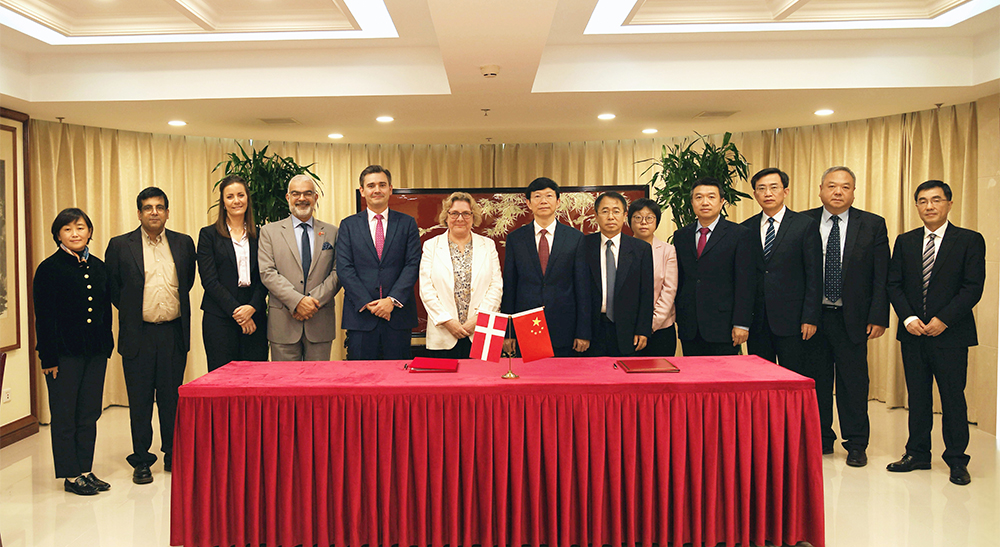杨凯迪:葡萄膜黑色素瘤发生的分子遗传学机制与免疫微环境特征
时间:2024-08-29 10:00:30 热度:37.1℃ 作者:网络
编者按:葡萄膜黑色素瘤(UM)是成年人眼内最常见的原发恶性肿瘤[1],起源于脉络膜、睫状体或虹膜中的黑色素细胞,约有90%UM位于脉络膜,6%发生于睫状体,4%发生于虹膜[2-4]。它是一种高转移性肿瘤,约50%的UM患者发生肝转移[5-7],预后不良。
紫外线照射(UVR)在UM发病中的作用仍有争议[8-13]。此外,经常暴露于焊接、油烟、石棉等环境中也会增加UM发生的风险[14,15]。性别对UM发病率影响并不显著,因种族等多因素影响UM发病率在不同地区也不同。
本期「专家组稿」由吉林大学第一医院吴荻教授担任执行主编,与吉林大学第一医院肿瘤内科硕士杨凯迪共同分享《葡萄膜黑色素瘤发生的分子遗传学机制与免疫微环境特征》,为医者和患者提供更多参考。
一、UM发病的分子遗传学特征
在UM中已被证实有两个突变中枢,且每个中枢内的基因突变几乎互斥。
第一个突变中枢由GNAQ/GNA11信号通路构成,包含GNAQ、GNA11、CysLTR2和PLCB4等基因,该突变中枢影响了95%以上UM的起始事件,通常与预后无关[16-18]。UM基因突变频率分析发现,80%以上的UM存在GNAQ/GNA11基因突变[17, 19]。GNAQ/GNA11突变可以通过PLCB-PKC-MEK、PI3K-Akt-MTOR、Trio-Rho/Rac-YAP(Yes-相关蛋白)、粘着斑激酶(FAK)-YAP以及ADP核糖基化因子(ARF6)和Hippo/YAP等通路促进UM发生[4,19-25]。CYSTLR2和PLCB4分别是GNAQ/GNA11上游受体和下游靶点,约有10%UM中可见两者的突变[16,18]。
第二个突变中枢成员有BAP1、SF3B1和EIF1AX,简称BSE事件,是UM发展的晚期事件,对疾病转移和预后有预测意义[26-29]。BAP1基因位于染色体3p21.1,编码去泛素化酶BAP1,多定位于细胞核中[30-32]。BAP1与多个染色质调节和转录调控因子结合发挥转录共激活和共阻遏的作用,参与细胞的多个生物过程[33]。SF3B1基因位于染色体2q33.1,编码剪接因子3B蛋白复合体的亚基1,是U2小核核糖核蛋白复合体的组成部分,其主要功能是参与前体mRNA的剪接去除内含子。EIF1AX基因位于XP22染色体上,基因表达产物参与真核细胞基因翻译启动过程。EIF1AX突变被认为是一种保护性的突变,约有14%-20%的UM患者存在该基因突变[28]。
丢失一个3号染色体(M3)是原发性UM中最常见的染色体畸形,BAP1缺失的UM中通常伴有M3的发生。侵袭性UM的发生满足Knudson关于肿瘤抑制子的“两击”假说,位于染色体3p21的一个BAP1因M3的发生而缺失,另一个BAP1又发生缺失突变[26,34]。UM中染色体8q扩增与8p丢失同时发生,提示预后更差[35]。UM中还常伴有染色体6p扩增和6q丢失两种形式,染色体6p扩增是UM最早发现的染色体异常[36]。
二、UM免疫微环境特点及形成原因
研究发现,UM的TMB低[37],特别是转移性UM,具有独特的免疫抑制微环境,被认为是“免疫冷”肿瘤[38]。
UM长期处于免疫抑制状态,主要原因是眼睛是免疫豁免器官[39]。房水(AH)中含有IL-6、MIF、TGF-β等多种免疫抑制细胞因子,抑制免疫细胞浸润[39-41]。此外,UM还分泌IL-10、VEGF、TGF-β和MIF等细胞因子,抑制原发和转移部位的NK细胞介导的细胞溶解和其他炎性细胞功能来创建免疫抑制环境[41-44]。另一个原因是M2-巨噬细胞大量浸润,UM中染色体8q扩增和M3等遗传改变与M2-巨噬细胞浸润密切相关,且与预后不良有关[45,46]。
多项研究发现,原发性UM肿瘤浸润免疫细胞主要是T细胞和M2-巨噬细胞[45,47,48],几乎没有B细胞或NK细胞[43,49,50]。原发UM中肿瘤浸润淋巴细胞(TIL)主要以CD8+T细胞为主[51,52]。转移性UM中,CD8+ TIL数量少,且主要位于瘤周,而CD4+TIL却显示出较高的血管周围密度[53,54]。UM细胞分泌的IL-10、CSF-1、MIF、CCL2、CXCL10等细胞因子以及BAP1丢失等遗传改变可以诱导单核细胞向M2极化[46,55],所以UM TME中有大量表达CD68+和CD163+ M2-巨噬细胞[48]。研究结果提示,UM TME中M2-巨噬细胞增加与不良预后相关[48,56]。
三、UM免疫治疗现状
肿瘤免疫原性低及眼睛是免疫特权器官是UM免疫治疗疗效不佳的主要原因[37,57,58]。已有研究发现Tebentafusp(IMCgp100)在治疗UM时,特别是对转移性UM展示了可行且乐观的结果[59]。它是新型双特异性分子,其含有亲和力增强的TCR,可以将gp100阳性UM细胞重定向T细胞而激活免疫反应[60-62]。关于UM免疫治疗研究较少,未来UM免疫治疗可以参考其他冷肿瘤变热的疗法。
四、展望
UM是罕见的黑色素瘤亚型,最常发生于脉络膜上,约50%的患者发生肝转移。高加索人种中UM发病率高,性别对UM发病无明显影响。焊接等因素是UM发病的高危因素,UVR在UM发病中的影响存在争议。目前已知UM常有GNAQ/GNA11、BAP1、EIF1AX和SF3B1基因以及3号、8号和6号染色体等遗传学变化,但它们如何驱动UM仍不明确,有待进一步研究。眼睛是免疫豁免器官,且AH中含有多种免疫抑制因子,抑制免疫细胞浸润。研究发现,M3的发生和染色体8q扩增等遗传改变与M2-巨噬细胞浸润相关,双重因素导致UM处于免疫抑制微环境中。未来进一步理解UM遗传学改变以及它们之间的联系可以帮助更好的预测疾病的发展、转移、预后和治疗情况。
参考文献
1. Yonekawa, Y. and I.K. Kim, Epidemiology and management of uveal melanoma. Hematol Oncol Clin North Am, 2012. 26(6): p. 1169-84.
2. Shields, C.L., et al., Iris melanoma: features and prognosis in 317 children and adults. J aapos, 2012. 16(1): p. 10-6.
3. Shields, C.L., et al., Metastasis of uveal melanoma millimeter-by-millimeter in 8033 consecutive eyes. Arch Ophthalmol, 2009. 127(8): p. 989-98.
4. Park, J.J., et al., Oncogenic signaling in uveal melanoma. Pigment Cell Melanoma Res, 2018. 31(6): p. 661-672.
5. Schmidt-Pokrzywniak, A., et al., Assessment of the effect of iris colour and having children on 5-year risk of death after diagnosis of uveal melanoma: a follow-up study. BMC Ophthalmol, 2014. 14: p. 42.
6. Spagnolo, F., G. Caltabiano, and P. Queirolo, Uveal melanoma. Cancer Treat Rev, 2012. 38(5): p. 549-53.
7. Jager, M.J., et al., Uveal melanoma. Nat Rev Dis Primers, 2020. 6(1): p. 24.
8. Ghazawi, F.M., et al., Uveal melanoma incidence trends in Canada: a national comprehensive population-based study. Br J Ophthalmol, 2019. 103(12): p. 1872-1876.
9. Singh, A.D., et al., Sunlight exposure and pathogenesis of uveal melanoma. Surv Ophthalmol, 2004. 49(4): p. 419-28.
10. Holly, E.A., et al., Uveal melanoma in relation to ultraviolet light exposure and host factors. Cancer Res, 1990. 50(18): p. 5773-7.
11. Tucker, M.A., et al., Sunlight exposure as risk factor for intraocular malignant melanoma. N Engl J Med, 1985. 313(13): p. 789-92.
12. Seddon, J.M., et al., Host factors, UV radiation, and risk of uveal melanoma. A case-control study. Arch Ophthalmol, 1990. 108(9): p. 1274-80.
13. Vajdic, C.M., et al., Artificial ultraviolet radiation and ocular melanoma in Australia. Int J Cancer, 2004. 112(5): p. 896-900.
14. Nayman, T., et al., Uveal Melanoma Risk Factors: A Systematic Review of Meta-Analyses. Curr Eye Res, 2017. 42(8): p. 1085-1093.
15. Napolitano, A., et al., Minimal asbestos exposure in germline BAP1 heterozygous mice is associated with deregulated inflammatory response and increased risk of mesothelioma. Oncogene, 2016. 35(15): p. 1996-2002.
16. Moore, A.R., et al., Recurrent activating mutations of G-protein-coupled receptor CYSLTR2 in uveal melanoma. Nat Genet, 2016. 48(6): p. 675-80.
17. Vader, M.J.C., et al., GNAQ and GNA11 mutations and downstream YAP activation in choroidal nevi. Br J Cancer, 2017. 117(6): p. 884-887.
18. Johansson, P., et al., Deep sequencing of uveal melanoma identifies a recurrent mutation in PLCB4. Oncotarget, 2016. 7(4): p. 4624-31.
19. Van Raamsdonk, C.D., et al., Frequent somatic mutations of GNAQ in uveal melanoma and blue naevi. Nature, 2009. 457(7229): p. 599-602.
20. Chua, V., et al., Dysregulated GPCR Signaling and Therapeutic Options in Uveal Melanoma. Mol Cancer Res, 2017. 15(5): p. 501-506.
21. Yoo, J.H., et al., ARF6 Is an Actionable Node that Orchestrates Oncogenic GNAQ Signaling in Uveal Melanoma. Cancer Cell, 2016. 29(6): p. 889-904.
22. Chen, X., et al., RasGRP3 Mediates MAPK Pathway Activation in GNAQ Mutant Uveal Melanoma. Cancer Cell, 2017. 31(5): p. 685-696.e6.
23. Yu, F.X., et al., Mutant Gq/11 promote uveal melanoma tumorigenesis by activating YAP. Cancer Cell, 2014. 25(6): p. 822-30.
24. Feng, X., et al., Hippo-independent activation of YAP by the GNAQ uveal melanoma oncogene through a trio-regulated rho GTPase signaling circuitry. Cancer Cell, 2014. 25(6): p. 831-45.
25. Feng, X., et al., A Platform of Synthetic Lethal Gene Interaction Networks Reveals that the GNAQ Uveal Melanoma Oncogene Controls the Hippo Pathway through FAK. Cancer Cell, 2019. 35(3): p. 457-472.e5.
26. Harbour, J.W., et al., Frequent mutation of BAP1 in metastasizing uveal melanomas. Science, 2010. 330(6009): p. 1410-3.
27. Furney, S.J., et al., SF3B1 mutations are associated with alternative splicing in uveal melanoma. Cancer Discov, 2013. 3(10): p. 1122-1129.
28. Martin, M., et al., Exome sequencing identifies recurrent somatic mutations in EIF1AX and SF3B1 in uveal melanoma with disomy 3. Nat Genet, 2013. 45(8): p. 933-6.
29. Harbour, J.W., et al., Recurrent mutations at codon 625 of the splicing factor SF3B1 in uveal melanoma. Nat Genet, 2013. 45(2): p. 133-5.
30. Yu, H., et al., The ubiquitin carboxyl hydrolase BAP1 forms a ternary complex with YY1 and HCF-1 and is a critical regulator of gene expression. Mol Cell Biol, 2010. 30(21): p. 5071-85.
31. Koopmans, A.E., et al., Clinical significance of immunohistochemistry for detection of BAP1 mutations in uveal melanoma. Mod Pathol, 2014. 27(10): p. 1321-30.
32. Gallenga, C.E., et al., Genetic Basis and Molecular Mechanisms of Uveal Melanoma Metastasis: A Focus on Prognosis. Front Oncol, 2022. 12: p. 828112.
33. Bononi, A., et al., BAP1 regulates IP3R3-mediated Ca(2+) flux to mitochondria suppressing cell transformation. Nature, 2017. 546(7659): p. 549-553.
34. Knudson, A.G., Jr., Mutation and cancer: statistical study of retinoblastoma. Proc Natl Acad Sci U S A, 1971. 68(4): p. 820-3.
35. Trolet, J., et al., Genomic profiling and identification of high-risk uveal melanoma by array CGH analysis of primary tumors and liver metastases. Invest Ophthalmol Vis Sci, 2009. 50(6): p. 2572-80.
36. Prescher, G., N. Bornfeld, and R. Becher, Nonrandom chromosomal abnormalities in primary uveal melanoma. J Natl Cancer Inst, 1990. 82(22): p. 1765-9.
37. Krauthammer, M., et al., Exome sequencing identifies recurrent somatic RAC1 mutations in melanoma. Nat Genet, 2012. 44(9): p. 1006-14.
38. Galon, J. and D. Bruni, Approaches to treat immune hot, altered and cold tumours with combination immunotherapies. Nat Rev Drug Discov, 2019. 18(3): p. 197-218.
39. Niederkorn, J.Y., Ocular immune privilege and ocular melanoma: parallel universes or immunological plagiarism? Front Immunol, 2012. 3: p. 148.
40. Ly, L.V., et al., Inflammatory cytokines in eyes with uveal melanoma and relation with macrophage infiltration. Invest Ophthalmol Vis Sci, 2010. 51(11): p. 5445-51.
41. Apte, R.S. and J.Y. Niederkorn, Isolation and characterization of a unique natural killer cell inhibitory factor present in the anterior chamber of the eye. J Immunol, 1996. 156(8): p. 2667-73.
42. Apte, R.S., E. Mayhew, and J.Y. Niederkorn, Local inhibition of natural killer cell activity promotes the progressive growth of intraocular tumors. Invest Ophthalmol Vis Sci, 1997. 38(6): p. 1277-82.
43. Apte, R.S., et al., Cutting edge: role of macrophage migration inhibitory factor in inhibiting NK cell activity and preserving immune privilege. J Immunol, 1998. 160(12): p. 5693-6.
44. Rook, A.H., et al., Effects of transforming growth factor beta on the functions of natural killer cells: depressed cytolytic activity and blunting of interferon responsiveness. J Immunol, 1986. 136(10): p. 3916-20.
45. Bronkhorst, I.H. and M.J. Jager, Uveal melanoma: the inflammatory microenvironment. J Innate Immun, 2012. 4(5-6): p. 454-62.
46. Gezgin, G., et al., Genetic evolution of uveal melanoma guides the development of an inflammatory microenvironment. Cancer Immunol Immunother, 2017. 66(7): p. 903-912.
47. Meecham, W.J., D.H. Char, and S. Kaleta-Michaels, Infiltrating lymphocytes and antigen expression in uveal melanoma. Ophthalmic Res, 1992. 24(1): p. 20-6.
48. Bronkhorst, I.H., et al., Detection of M2-macrophages in uveal melanoma and relation with survival. Invest Ophthalmol Vis Sci, 2011. 52(2): p. 643-50.
49. Viel, S., et al., TGF-β inhibits the activation and functions of NK cells by repressing the mTOR pathway. Sci Signal, 2016. 9(415): p. ra19.
50. Tobal, K., et al., Characterization of cellular infiltration in choroidal melanoma. Melanoma Res, 1993. 3(1): p. 63-5.
51. Durante, M.A., et al., Single-cell analysis reveals new evolutionary complexity in uveal melanoma. Nat Commun, 2020. 11(1): p. 496.
52. Bartlett, E.K., et al., Human melanoma metastases demonstrate nonstochastic site-specific antigen heterogeneity that correlates with T-cell infiltration. Clin Cancer Res, 2014. 20(10): p. 2607-2616.
53. Krishna, Y., et al., Inflammatory cell infiltrates in advanced metastatic uveal melanoma. Hum Pathol, 2017. 66: p. 159-166.
54. Qin, Y., et al., Parallel profiling of immune infiltrate subsets in uveal melanoma versus cutaneous melanoma unveils similarities and differences: A pilot study. Oncoimmunology, 2017. 6(6): p. e1321187.
55. Mantovani, A. and P. Allavena, The interaction of anticancer therapies with tumor-associated macrophages. J Exp Med, 2015. 212(4): p. 435-45.
56. Narasimhaiah, D., et al., DNA alteration-based classification of uveal melanoma gives better prognostic stratification than immune infiltration, which has a neutral effect in high-risk group. Cancer Med, 2019. 8(6): p. 3036-3046.
57. Goodman, A.M., et al., Microsatellite-Stable Tumors with High Mutational Burden Benefit from Immunotherapy. Cancer Immunol Res, 2019. 7(10): p. 1570-1573.
58. Forschner, A., et al., Tumor mutation burden and circulating tumor DNA in combined CTLA-4 and PD-1 antibody therapy in metastatic melanoma - results of a prospective biomarker study. J Immunother Cancer, 2019. 7(1): p. 180.
59. Damato, B.E., et al., Tebentafusp: T Cell Redirection for the Treatment of Metastatic Uveal Melanoma. Cancers (Basel), 2019. 11(7).
60. Martinez-Perez, D., et al., Gp-100 as a Novel Therapeutic Target in Uveal Melanoma. Cancers (Basel), 2021. 13(23).
61. Liddy, N., et al., Monoclonal TCR-redirected tumor cell killing. Nat Med, 2012. 18(6): p. 980-7.
62. de Vries, T.J., et al., High expression of immunotherapy candidate proteins gp100, MART-1, tyrosinase and TRP-1 in uveal melanoma. Br J Cancer, 1998. 78(9): p. 1156-61.


